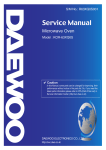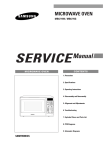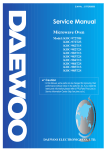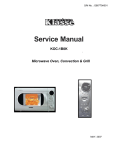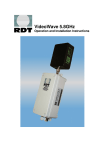Download Daewoo KOC-984T2S Service manual
Transcript
S/M NO. : C984T2S132 Service Manual Microwave Oven Model: KOC-984T2S13 ✔ Caution : In this Manual, some parts can be changed for improving, their performance without notice in the parts list. So, if you need the latest parts information,please refer to PPL(Parts Price List) in Service Information Center (http://svc.dwe.co.kr). DAEWOO ELECTRONICS CO., LTD. http://svc.dwe.co.kr PRECAUTIONS TO BE OBSERVED BEFORE AND DURING SERVICING TO AVOID POSSIBLE EXPOSURE TO EXCESSIVE MICROWAVE ENERGY (a) Do not operate or allow the oven to be operated with the door open. (b) Make the following safety checks on all ovens to be serviced before activating the magnetron or other microwave source, and make repairs as necessary: (1) Interlock operation, (2) Proper door closing, (3) Seal and sealing surfaces (arcing, wear, and other damage), (4) Damage to or loosening of hinges and latches, (5) Evidence of dropping or abuse. (c) Before turning on power to the microwave oven for any service test or inspection within the microwave generating compartments, check the magnetron, wave guide or transmission line, and cavity for proper alignment, integrity, and connections. (d) Any defective or misadjusted components in the interlock, monitor, door seal, and microwave generation and transmission systems shall be repaired, replaced, or adjusted by procedures described in this manual before the oven is released to the owner. (e) A microwave leakage check to verify compliance with the Federal performance standard should be performed on each oven prior to release to the owner. TABLE OF CONTENTS SAFETY AND PRECAUTIONS ...........................................................................................................................................2 SPECIFICATIONS ...............................................................................................................................................................3 EXTERNAL VIEW................................................................................................................................................................4 1. OUTER DIMENSION ............................................................................................................................................4 2. FEATURE DIAGRAM ...........................................................................................................................................5 INSTALLATION ...................................................................................................................................................................6 EARTHING INSTRUCTIONS...............................................................................................................................................6 CONTROL PANEL ..............................................................................................................................................................7 DISASSEMBLY AND ASSEMBLY......................................................................................................................................8 INTERLOCK MECHANISM AND ADJUSTMENT.............................................................................................................17 TROUBLE SHOOTING GUIDE .........................................................................................................................................18 MEASUREMENT AND TEST ............................................................................................................................................24 1. MEASUREMENT OF THE MICROWAVE POWER OUTPUT............................................................................24 2. ELECTRICAL CONTINUITY CHECK OF INTERLOCK SWITCH ......................................................................25 3. MICROWAVE RADIATION TEST.......................................................................................................................26 4. COMPONENT TEST PROCEDURE ..................................................................................................................27 WIRING DIAGRAM............................................................................................................................................................28 SCHEMATIC DIAGRAM....................................................................................................................................................29 EXPLODED VIEWS AND PARTS LIST ............................................................................................................................32 PRINTED WIRING BOARD ...............................................................................................................................................35 P.C.B CIRCUIT DIAGRAM ................................................................................................................................................40 1 SAFETY AND PRECAUTIONS 1. FOR SAFE OPERATION Damage that allows the microwave energy (that cooks or heats the food) to escape will result in poor cooking and may cause serious bodily injury to the operator. IF ANY OF THE FOLLOWING CONDITIONS EXIST, OPERATOR MUST NOT USE THE APPLIANCE. (Only a trained service personnel should make repairs.) (1) A broken door hinge. (2) A broken door viewing screen. (3) A broken front panel, oven cavity. (4) A loosened door lock. (5) A broken door lock. The door gasket plate and oven cavity surface should be kept clean. No grease, soil or spatter should be allowed to build up on these surfaces or inside the oven. DO NOT ATTEMPT TO OPERATE THIS APPLIANCE WITH THE DOOR OPEN. The microwave oven has concealed switches to make sure the power is turned off when the door is opened. Do not attempt to defeat them. DO NOT ATTEMPT TO SERVICE THIS APPLIANCE UNTIL YOU HAVE READ THIS SERVICE MANUAL. 2. FOR SAFE SERVICE PROCEDURES. 1. If the oven is operative prior to servicing, a microwave emission check should be performed prior to servicing the oven. 2. If any certified oven unit is found to servicing, a microwave emission check should be performed prior to servicing the oven. (1) inform the manufacturer, importer or assembler, (2) repair the unit at no cost to the owner, (3) attempt to ascertain the cause of the excessive leakage, (4) tell the owner of the unit not to use the unit until the oven has been brought into compliance. 3. If the oven operates with the door open, the service person should tell the user not to operate the oven and contact the manufacturer immediately. IMPORTANT The wire in this mains lead coloured in accordance with the following code. Green-and-yellow : Earth Blue : Neutral Brown : Live As the colours of the wires in the mains lead of this appliance may not correspond with the coloured markings identifying the terminals in your plug, proceed as follows: The wire which is coloured green-and-yellow must be connected to the terminal in the plug which is marked with the letter ‘E’, earth symbol or coloured green-and-yellow. The wire which is coloured blue must be connected to the terminal which is marked with the letter ‘N’ or coloured black. The wire which is coloured brown must be connected to the terminal which is marked with the letter ‘L’ or coloured red. NOTE : This oven is designed for counter-top use only. 2 SPECIFICATIONS MODEL KOC-984T2S13 POWER SUPPLY 240V-50Hz POWER CONSUMPTION MICROWAVE 1450 W GRILL 1200W CONVECTION 1550W PROGRAM COOK 1850W COMBINATION 1550W (Sequential) MICROWAVE ENERGY OUTPUT 1000W (IEC705) MICROWAVE FREQUENCY 2450MHz OUTSIDE DIMENSIONS (W X H X D) 526 X 345 X 496 mm (20.7 X 13.6 X 19.5 inch) CAVITY DIMENSIONS (W X H X D) 335 X 250 X 339 mm (13.2 X 9.8 X13.3 inch) NET WEIGHT Approx. 21 kg (46.3 Ibs.) TIMER 60 minutes FUNCTION SELECTIONS MICROWAVE / GRILL / CONVECTION / COMBI M/W POWER SELECTIONS 10 LEVELS CAVITY VOLUME 1.0 Cu.Ft. * Specifications are subject to change without notice. 3 EXTERNAL VIEW 345 320 1. OUTER DIMENSION 350 234 526 496 4 2. FEATURE DIAGRAM 1 Door seal—Door seal maintains the microwave energy within the oven cavity and prevents microwave leakage. 6 Safety interlock system 7 Control panel 8 Turntable tray—Rotates during cooking and ensure even distribution of Microwaves. It can also be used as a cooking utensil. 2 Door hook—When the door is closed, it will automatically shut. If the door is opened while the oven is operating, the magnetron will immediately stop operating. 9 Oven front plate 3 Door viewing screen—Allows viewing of food. The screen is designed so that light can pass through, but not the microwave. 0 Rotating base—This fits over the shaft in the center of the ovens cavity floor. This is to remin in the oven for all cooking. It should only be removed for cleaning. 4 Top heater—Turn on when convection, grill and combi cooking is selected. q Under heater 5 Oven lamp—Automatically turns on during oven operating. w Metal rack e Convection outlet & Fan 5 INSTALLATION 1. Steady, flat location This microwave oven should be set on a steady, flat surface. This microwave oven is designed for counter top use only. 2. Leave space behind and side All air vents should be kept a clearance. If all vents are covered during operation, the oven may overheat and, eventually, cause failure. 3. Away from Radio and TV sets Poor television reception and radio interference may result if the oven is located close to a TV, Radio, antenna or feeder and so on. Position the oven as far from them as possible. 4. Away from heating appliances and water taps Keep the oven away from hot air, steam or splash when choosing a place to position it, or the insulation might be adversely affected and breakdowns occur. 5. Power supply • Check your local power source. This microwave oven requires a current of approximately 10 amperes, 240V, 50Hz. • Power supply cord is about 1.8 meters long. • The voltage used must be the same as specified on this oven. Using a higher voltage may result in a fire or other accident causing oven damage. Using low voltage will cause slow cooking. We are not responsible for damage resulting from use of this oven with a voltage of ampere fuse other than those specified. • This appliance is supplied with cable of special type, which, if damaged, must be repaired with cable of same type. • Such a cable can be purchased from DAEWOO and must be installed by a Qualified Person. 6. Examine the oven after unpacking for any damage such as: A misaligned door, broken door or a dent in cavity. If any of the above are visible, DO NOT INSTALL, and notify dealer immediately. 7. Do not operate the oven if it is colder than room temperature. (This may occur during delivery in cold weather.) Allow the oven to become room temperature before operating. EARTHING INSTRUCTIONS This appliance must be earthed. In the event of an electrical short circuit, earthing reduces the risk of the electric shock by providing an escape wire for the electric current. This appliance is equipped with a cord having a earthing wire with a earthing plug. The plug must be plugged into an outlet that is properly installed and earthed. WARNING Improper use of the earthing plug can result in a risk of electric shock. Consult a qualified electrician of serviceman if the earthing instructions are not completely understood, or if doubt exists as to whether the appliance is properly earthed, and either: If it is necessary to use an extension cord, use only a 3-wire extension cord that has a 3-blade earthing plug, and a 3-slot receptacle that will accept the plug on the appliance. The marked rating of the extension cord should be equal to or greater than the electrical rating of the appliance, or Do not use an extension cord. 6 CONTROL PANEL When blinking, the oven is operating in “COMBI” cooking mode. When binking, the oven is operating in “WEIGHT DEFROST” cooking mode. When blinking, the oven is operating in “GRILL” cooking mode. When blinking, the oven is operating in “TIME DEFROST” cooking mode. DEFROST When blinking, the oven is operating in “MICROWAVE” cooking mode. When blinking, the oven is operating in “PROGRAM COOK” cooking mode. When Blinking, the oven is operating in “PIE” cooking mode. When blinking, the oven is operating in “CONVECTION” cooking mode. Microwave Power LevelUsed to select the variable microwave power level. If this button(pad) is pressed for more than 1.3 sec, number is scrolled up automatically. MW GRILLL PROGRAM PIE COOK COMBI TEMP COOK WEIGHT - TIME When blinking, the oven is operating in weight input mode. KG M/W DEFROST PIE GRILL COMBI TEMP Temperature Button(pad)Used to set desired temperature. If this button is pressed for more than 1.3 sec, number is scrolled up automatically. Function Buttons(pads)Used select desired cooking function • M/W : MICROWAVE • GRILL • DEFROST : TIME or WEIGHT DEFROST • TEMP : CONVECTION • COMBI : COMBINATION • PIE • PROGRAM COOK PROGRAM COOK 1. ROAST BEEF 2. ROAST PORK 3. ROAST CHICKEN 4. FISH FILLET 5. VEGETABLE SPEEDY COOK + Dial KnobUsed to input the cooking time and weight. Speedy Cook Button(pad)Used to program quickly cooking time in 30 sec increments. _ STOP/CLEAR START/CLOCK Stop/Clear ButtonUsed to pause and clear all information manually put into the oven. Start/Clock ButtonUsed to start the selected cooking cycle and to set time. 7 DISASSEMBLY AND ASSEMBLY Cautions to be observed when trouble shooting. Unlike many other appliances, the microwave oven is high-voltage, high-current equipment. It is completely safety during normal operation. However, carelessness in servicing the oven can result in an electric shock or possible danger from a short circuit. You are asked to observe the following precautions carefully. 1. Always remove the power plug from the outlet before servicing. 2. Use an insulated screwdriver and ware rubber gloves when servicing the high voltage side. 3. Discharge the high voltage capacitor before touching any oven components or wiring. (1) Check the earthed. Do not operate on a 2-wire extension cord. The microwave oven is designed to be used when earthed. It is imperative, therefore, to makes sure it is earthed properly before beginning repair work. (2) Warning about the electric charge in the high voltage capacitor. For about 30 seconds after the operation stopped and electric charge remains in the high voltage capacitor. When replacing or checking parts, short between oven chassis and the negative high terminal of the high voltage capacitor, by using a properly insulated screwdriver to discharge. 4. When the 12A fuse is blown out due to the operation of the monitor switch; replace primary interlock switch, secondary interlock switch and interlock monitor switch. 5. After repair or replacement of parts, make sure that the screws are properly tightened, and all electrical connections are tightened. 6. Do not operate without cabinet. CAUTION : Service personnel should remove their watches whenever working close to or replacing the magnetron. WARNING : When servicing the appliance, need a care of touching or replacing high potential parts because of electrical shock or exposing microwave. These parts are as follows - HV Transformer, Magnetron, HV Capacitor, HV Diode. 8 1. To remove cabinet 1) Remove four screws on cabinet back. 2) Push the cabinet backward. 2. To remove guide wind assembly 1) Remove two screws for earthing and for fixing to rear-plate. 2) Remove the noise filter from the guide wind. 3) Pull the fan from the motor shaft. 4) Remove two screws which secure the motor shaded pole. 5) Remove the motor shaded pole. 6) Reverse the above steps for reassembly. 9 3. To remove H.V. transformer 1) Remove four screws which secure the H.V. Transformer to the base plate. 2) Remove the H.V. Transformer. 3) Reverse the above steps for reassembly. 4. To remove high voltage capacitor 1) Remove a screw which secure the grounding ring terminal of the H.V. diode and the capacitor holder. 2) Remove the H.V. diode from the capacitor holder. 3) Reverse the above steps for reassembly. High voltage circuit wiring 10 5. To remove magnetron 1) Remove three screws which secure the magnetron. 2) Remove the magnetron. 3) Reverse the above steps for reassembly. CAUTION : Never install the magnetron without the metallic gasket plate which is packed with each magnetron to prevent microwave leakage. Whenever repair work is carried out on magnetron, check the microwave leakage. It shall not exceed 4mW/cm2 for a fully assembled oven with door normally closed. 11 ✔ Caution: In this Service Manual, some parts can be changed for improving, their performance without notice in the parts list. So, if you need the latest parts information, please refer to PPL(Parts Price List) in Service information Center(http://svc.dwe.co.kr) 6. To remove control panel assembly (1) Remove a screw which secure the control panel assembly to the oven front plate. At the same time, draw forward the control panel assembly from the oven front plate. (2) Remove the dial knob. (3) Remove ten screws which secure the main and sub PCB assembly to control panel. (4) Remove buttons. (5) Remove the window display. B11 B01 B07 B02 B13 B12 B08 B10 B04 B09 B06 B05 B03 REF NO. PART CODE PART NAME B01 3516719200 CONTROL-PANEL ABS XR-401 1 B02 3511602900 DECORATOR C/P *T STS304 T0.6 H/L 1 B03 3511603000 CEDORATOR C/P *U STS304 T0.6 H/L 1 B04 3511603110 DECORATOR C-PANEL PMMA IF-850 1 SMOG B05 3511602800 DECORATOR RING ABS XR-401 1 COATING B06 3513404620 KNOB VOLUME ABS XR-401 1 COATING B07 3516905120 BUTTON FUNCTION ABS XR-401 1 COATING B08 3516907200 BUTTON FUNCTION ABS XR-401 1 COATING B09 3516906320 BUTTON FUNCTION ABS XR-401 2 COATING B10 PKBPMSYB00 PCB SUB AS KOC-984T 1 B11 7621301011 B12 PKMPMSYB10 B13 7121401611 DESCRIPTION Q’TY SCREW TAPPING T2S PAN 3X10 PW MFZN 6 PCB MAIN AS KOC-984T2S 1 SCREW TAPPING T2S PAN 4X16 MFZN 4 12 REMARK ✔ Caution: In this Service Manual, some parts can be changed for improving, their performance without notice in the parts list. So, if you need the latest parts information, please refer to PPL(Parts Price List) in Service information Center(http://svc.dwe.co.kr) 7. To remove door assembly 1) Remove two screws which secure the stopper hinge top. 2) Remove the door assembly from top plate of cavity. 3) Reverse the above steps for reassembly. NOTE : After replacing the door assembly, perform a check of correct alignment with the hinge and cavity front plate. 8. To remove door parts 1) Remove the gasket door. 2) Remove two screws holding the handle. 3) Remove the handle from the frame door. 4) Remove the door seal ass’y. 5) Remove the hook and spring. 6) Remove the barrier-screen *o. REF NO. PART CODE PART NAME DESCRIPTION A01 3511708400 DOOR SEAL AS KOC-971C0S 1 A02 3513101100 HOOK POM 1 A03 3515101300 SPRING HOOK PW1 1 A04 3517004080 BARRIER-SCREEN *O TEMPERED GLASS T3.2 1 A05 3512204000 FRAME DOOR ABS XR-401 1 A06 3511603200 DECORATOR DOOR *T STS430 T0.6 H/L 1 A07 3511603320 DECORATOR DOOR *U STS430 T0.6 H/L 1 A08 3515203600 STOPPER HINGE *T AS KOC-970T 1 A09 3512602820 HANDLE DOOR AL ALUMITE SUS 1 A10 3510900300 CAP HANDLE *T ABS XR-401 1 A11 3510900400 CAP HANDLE *U ABS XR-401 1 A12 7001503311 SCREW MACHINE PAN 5X33 MFZN 2 A13 3512300800 GASKET DOOR PBT 1 13 Q’TY REMARK 9. Method to reduce the gap between the door seal and the oven front surface. (1) To reduce gap located on part ‘A’ • Loosen two screws on stopper hinge top, and then push the door to contact the door seal to oven front surface. • Tighten two screws. A C B D (2) To reduce gap located on part ‘B’ • Loosen two screws on stopper hinge under, and then push the door to contact the door seal to oven front surface. • Tighten two screws. (3) To reduce gap located on part ‘C’ • Loosen a screw on interlock switch assembly located bottom of oven body. • Draw the interlock switch assembly inward as possible to engage with hook on the door bottom. • Tighten a screw. (4) To reduce gap located on part ‘D’ • Loosen a screw on interlock switch assembly located top of oven body. • Following steps are same as step(3). NOTE : Small gap may be acceptable if the microwave leakage does not exceed 1mW/cm2. NOTE : The door on a microwave oven is designed to act as an electronic seal preventing the leakage of microwave energy from the oven cavity during the cook cycle. This function does not require that the door be air-tight, moisture (condensation) Tight or light-tight. Therefore, the occasional appearance of moisture, light or the sensing of gentle warm air movement around the oven door is not abnormal and do not of themselves, indicate a leakage of microwave energy from the oven cavity. If such were the case, your oven could not be equipped with a bent, the very purpose of which is to exhaust the vapor-laden air from the oven cavity. 14 10. To remove motor syncro and under heater: 1) Cut the syncro motor cover parts from the base plate. 2) Remove two screws which secure the motor syncro and supporter to bracket syncro motor. 3) Remove two screws and under heater assembly in cavity. 11. To remove grill heater assembly 1) Remove two screws which secure the cover insulator *t to top plate. 2) Remove the harness betweens heaters. 3) Remove two screws for removing heater brackets. 4) Remove heaters. 5) Reverse the above steps for reassembly. 15 12. To remove convection part assembly 1) Remove cover *b and cover insulator *b protecting convection part assembly. - release two lances of cover insulator *b. 2) Remove four screws which secure the convection part assembly to the cavity rear plate. 3) Remove a nut holding the convection fan and the pipe. 4) Remove twoscrews which secure the bracket motor to cover insulator. 5) Remove the cooling fan. 6) Remove two screws which secure the motor shaded pole to the bracket motor. 7) Reverse the above steps for reassembly. 16 INTERLOCK MECHANISM AND ADJUSTMENT The door lock mechanism is a device which has been specially designed to completely eliminate microwave radiation when the door is opened during operation, and thus to perfectly prevent the danger resulting from the leakage of microwave. 1. Primary interlock switch When the door is closed, the hook locks the oven door. If the door is not closed properly, the oven will not operate. When the door is closed, the hook pushes the button of the microswitch. Then the button of the primary interlock switch bring it under “ON” condition. 2. Secondary interlock switch, door open monitor switch and interlock monitor switch When the door is closed, the hook pushes the latch lever downward. The latch lever presses the button of the interlock monitor switch to bring it under “OFF” condition and presses the button of the secondary interlock switch and door open monitor switch to bring it under “ON” condition. ADJUSTMENT Interlock monitor switch When the door is closed, the interlock monitor switch should be opened before other switches are closed. When the door is opened, the interlock monitor switch should be closed after other switches are opend. 3. Adjustment steps (1) Loosen two mounting screws. (2) Adjust interlock switch assembly position. (3) Make sure that latch lever moves smoothly after adjustment is completed. (4) Tighten completely two mounting screws. NOTE : Microwave emission test should be performed after adjusting interlock mechanism. If the microwave emission exceed 4mW/cm2, readjust interlock mechanism. 17 TROUBLE SHOOTING GUIDE Following the procedures below to check if the oven is defective or not. 1. Check grounding before checking trouble. 2. Be careful of the high voltage circuit. 3. Discharge the high voltage capacitor. 4. When checking the continuity of the switches, fuse or high voltage transformer, disconnect one lead wire from these parts and check continuity with the AC plug removed. To do otherwise may result in a false reading or damage to your meter. NOTE : When electric parts are checked, be sure the power cord is not inserted into the wall outlet. Check wire harness, wiring, and connected of the terminals and power cord before check the parts listed below. (TROUBLE 1) Oven does not operate at all ; any inputs can not be accepted. Condition Fuse blows Check Check continuity of interlock monitor switch with door closed (COM NC) Result (COM NC) Continuity (COM Cause Remedy Malfunction of interlock monitor switch Replace Malfunction of interlock switch Replace Shorted contacts of primary interlock switch Replace Defective low voltage transformer Replace Defective high voltage transformer Replace Note 1. NC) No Continuity Check continuity of both primary and secondary interlock switch with door closed No Continuity Check continuity of primary interlock switch contact with door partially open until interlock monitor switch contact close (COM NC close) Continuity Note 1. Continuity 0 Ω or infinite Check continuity of primary winding of low voltage transformer Note 1. Approx. 150~210 (normal) Disconnect high voltage fuse and operate the unit Fuse again blows 18 Condition Outlet has proper voltage. Fuse does not blow. Check Result Cause Remedy Check continuity of magnetron No Continuity Defective magnetron Check continuity of noise filter board No Continuity Defective noise filter board Replace Check continuity of power supply cord No Continuity Open power supply cord Replace Normal Defective touch control circuit. Adjust Replace NOTE : All these switches must be replaced at the same time, please refer to (7. Interlock Mechanism and Adjust) for adjustment instructions. (TROUBLE 3) Condition Grill heater is not heated. Grill heater (top heater) is heated; Food will not become hot. Check Result Cause Remedy Check continuity of primary interlock switch No Continuity Manlfunction of prim ary interlock switch Adjust or Replace Check continuity of secondary interlock switch No Continuity Malfunction of secondary interlock switch Adjust or Replace Check continuity of heater No Continuity Defective heater Check D.C. voltage being supplied to RELAY (RY2) coil 0V Approx 12 VDC 19 Defective touch control circuit Faulty contacts of RELAY (RY2) or open relay coil Replace Replace Replace (TROUBLE 3) No microwave oscillation even though fan motor rotates. Condition Check Result No microwave oscillation Check continuity of high voltage fuse No Continuity Cause Remedy Replace high voltage fuse Check continuity of high voltage capacitor terminals with wires removed Continuity Defective high voltage transformer Replace Check continuity of high voltage rectifier in forward and backward direction with DC megger Continuity in backward direction Defective high voltage rectifier Replace Connect megger leads to magnetron terminal and magnetron body Continuity Defective magnetron Replace Check resistance of primary and secondary coil of high voltage transformer 0Ω or ∞ Defective high voltage transformer Replace Check continuity of magnetron with wires removed No Continuity Defective magnetron Replace Check continuity of filament terminal of high voltage transformer No Continuity Defective high voltage transformer Replace Check D.C. voltage being supplied to RELAY (RY1) coil 0V Defective touch control circuit Replace Approx 12 VDC Faulty contacts of RELAY (RY1) or open relay coil Replace 20 (TROUBLE 4) Display shows all figures selected, but oven does not start cooking, even though desired program and time are set and start pad is tapped. Condition Check Fan motor, turn table motor and oven lamp do not turn on Result Cause Check continuity of primary interlock switch No Continuity Malfunction of primary interlock awitch Adjust or replace Check continuity of secondary interlock and D.O.M. switch No Continuity Malfunction of secondary interlock and D.O.M. switch Adjust or replace Check D.C. voltage being supplied to RELAY (RY3, RY4) coil 0V Approx. 12 VDC (TROUBLE 5) Condition 1) Under heater is not heated. 2) Convection fan and motor does not rotate. Defective touch control circuit Faulty contacts of RELAY (RY3, RY4) or open relay coil Remedy Replace Replace 1) Under heater is not heated; Food will not become hot. 2) Convection motor does not rotate. Check Result Cause Remedy Check continuity of primary interlock switch No Continuity Manlfunction of prim ary interlock switch Adjust or Replace Check continuity of secondary interlock switch No Continuity Malfunction of secondary interlock switch Adjust or Replace Check continuity of heater (motor) No Continuity Defective heater (motor) Replace Check D.C. voltage being supplied to RELAY (RY5) coil 0V Defective touch control circuit Replace Approx. 12 VDC 21 Faulty contacts of RELAY (RY5) or open relay coil Replace (TROUBLE 4) The following visual conditions indicate a probable defective touch control circuit or button P.C.B. assembly. 1. Incomplete segments (1) Segments missing (2) Partial segments missing (3) Digit flickering other than normal fluorescent slight flickering (4) 0 does not display when power is on. 2. A distinct change in the brightness of one or more numbers exists in the display. 3. One or more digits in the display are not on when they should be. DEFROST MW GRILLL COMBI WEIGHT - TIME 4. Display indicates a number different from one touched.(for example, even if one touched 5, 3 appears in the display. 5. Specific numbers (for example, 2 or 3) do not display when the button is touched. PROGRAM PIE COOK TEMP COOK KG 6. Display does not count down or up with time cooking. 7. Oven is programable and cooks normally but no display shows. 8. Display obviously jumps in time while counting down. 9. Display counts down noticeably too fast while cooking. 10. Display does not show “o” when clear button is touched. 11. Oven lamp and turntable motor do not stop although cooking is finished. Check if the RELAY (RY5) contacts close and if they are close, replace touch control circuit. Condition Display does not show programming at all, even it keyboard is touched Check Check each button for continuity of the button keyboard for the following keyboard check procedure Result Cause Remedy Normal Malfunction of touch control circuit of control box sub-assembly Replace control box sub-assembly Normal Malfunction of button keyboard Replace the button keyboard NOTE : Before following the particular steps listed above in the trouble shooting guide for the button keyboard’s failure, please check for the continuity of each wire-harness between the button keyboard and P.C.B. assembly. 22 BUTTON KEYBOARD CHECK PROCEDURE 1. Type of button names key matrix and circuit diagram The tact switch keyboard consists of 10 keys which configurations are described above. 2. Key check procedure To determine if the tact switch keyboard is defective or not, check the continuity of each button(key) contacts with a multimeter. 11) PROGRAM COOK 12) TIME DEFROST 13) WEIGHT DEFROST 14) COMBI 15) GRILL 16) M/W 17) PIE 18) SPEEDY COOK 19) TEMP 10) START/CLOCK 11) STOP/CLEAR button button button button button button button button button button button : : : : : : : : : : : between 4 and 15 between 8 and 14 between 8 and 14 between 6 and 15 between 8 and 12 between 8 and 15 between 8 and 10 between 6 and 10 between 6 and 14 between 2 and 12 between 2 and 14 23 MEASUREMENT AND TEST 1. MEASUREMENT OF THE MICROWAVE POWER OUTPUT Microwave output power can be checked by indirectly measuring the temperature rise of a certain amount of water exposed to the microwave as directed below. PROCEDURE 1. Microwave power output measurement is made with the microwave oven supplied at rated voltage and operated at its maximum microwave power setting with a load of 1000±5cc of potable water. 2. The water is contained in a cylindrical borosilicate glass vessel having a maximum material thickness of 3 mm and an outside diameter of approximately 190 mm. 3. The oven and the empty vessel are at ambient temperature prior to the start of the test. The initial temperature of the water is 10±2˚C (50±3.6˚F) It is measured immediately before the water is added to the vessel. After addition of the water to the vessel, the load is immediately placed on the center of the shelf, which is in the lowest normal position. 4. Microwave power is switched on. 5. Heating time should be exactly A seconds. Heating time is measured while the microwave generator is operating at full power. The filament heat-up time for magnetron is not included. 6. The initial and final temperature of water is selected so that the maximum difference between the ambient and final water temperature is 5K. 7. The microwave power output P in watts is calculated from the following formula : P=4187 X ▲T/t • ▲T is difference between initial and ending temperature. • t is the heating time. The power measured should be B (refer to Specifications)W±10.0%. CAUTION : 1. Water load should be measured exactly to 1 liters. 2. Input power voltage should be exactly specified voltage(Refer to SPECIFICATIONS). 3. Ambient temperature should be 20±2˚C(68±3.6˚F) Heating time for power output: A(second) 70 64 60 56 52 49 47 44 42 40 38 B(W) 600 650 700 750 800 850 900 950 1000 1050 1100 24 2. ELECTRICAL CONTINUITY CHECK OF INTERLOCK SWITCH NOTE : Remove the power plug from the wall receptacle before testing. PROCEDURE 1. Primary interlock switch 1) Disconnect two connectors from primary interlock switch. 2) Connect the ohm-meter leads between the terminals of the primary interlock switch. 2. Read the value of resistance between the terminals of the switch, when the door is opened, and when the door is closed. 3. Secondary interlock switch 1) Disconnect two connectors from secondary interlock switch. 2) Connect the ohm-meter leads between the terminals of the secondary interlock switch. 3) Read the value of resistance between the terminals of the switch, when the door is opened, and when the door is closed. 4. Monitor interlock switch 1) Disconnect the lead wire connecting the primary interlock switch and interlock monitor switch from primary interlock switch terminal. 2) Connect the ohm-meter leads between the lead wire connector disconnected as item 1 and the power supply neutral plug pin. 3) Read the value of resistance between the lead wire connector and the power supply neutral plug pin, when the oven door is opened, and when the oven door is closed. JUDGEMENT • The value of resistance should be applied to the value specified below. Switch Door Open Door Closed Primary interlock switch ∞ 0 Secondary interlock switch ∞ 0 Interlock monitor circuit 0 ∞ • When value obtained is not acceptable, the switch should be replaced or adjusted again. 25 3. MICROWAVE RADIATION TEST WARNING : Make sure to check the microwave leakage before and after repair of adjustment. Always start measuring of an unknown field to assure safety for operating personnel from microwave energy. Do not place your hands into any suspected microwave radiation field unless the safe density level is known. Care should be taken not to place the eyes in direct line with the source of microwave energy. Slowly approach the unit under test until the radiometer reads an appreciable microwave leakage from the unit under the test. PROCEDURES 1. Prepare Microwave Energy Survey Meter, 600cc glass beaker, and glass thermometer 100˚C(212˚F). 2. Pour 275cc±15cc of tap water initially at 20±5˚C(68±9˚F) in the 600cc glass beaker with an inside diameter of approx. 95mm(3.5in.). 3. Place it at the center of the tray and set it in a cavity. 4. Close the door and operate the oven. 5. Measure the leakage by using Microwave Energy Survey Meter with dual ranges, set to 2450MHz. • Measured radiation leakage must not exceed the value prescribed below. Leakage for a fully assembled oven with door normally closed must be less than 4mW/cm2. • When measuring the leakage, always use the 5cm(2in.) space cone with probe. Hold the probe perpendicular to the cabinet and door. Place the space cone of the probe on the door, cabinet, door seem, door viewing screen, the exhaust air vents and the suction air vents. • Measuring should be in a counter-clockwise direction at a rate of 1 in./sec. If the leakage of the cabinet door seem is unknown, move the probe more slowly. • When measuring near a corner of the door, keep the probe perpendicular to the areas making sure the probe end at the base of the cone does not get closer than 2 in. from any metal. If it does not, erroneous reading may result. 26 4. COMPONENT TEST PROCEDURE • High voltage is present at the high voltage terminal of the high voltage transformer during any cooking cycle. • It is neither necessary nor advisable to attempt measurement of the high voltage. • Before touching any oven components or wiring, always unplug the oven from its power source and discharge the capacitor. 1. High voltage transformer (1) Remove connections from the transformer terminals and check continuity. (2) Normal readings should be as follows: Secondary winding...............Approx. 100Ω±10% Filament winding ............................Approx. 0.1Ω Primary winding..............................Approx. 1.5Ω 2. High voltage capacitor (1) Check continuity of capacitor with meter on the highest OHM scale. (2) A normal capacitor will show continuity for a short time, and then indicate 9MΩ once the capacitor is charged. (3) A shorted capacitor will show continuous continuity. (4) An open capacitor will show constant 9MΩ. (5) Resistance between each terminal and chassis should be infinite. 3. High voltage diode (A) Isolate the diode from the circuit by disconnecting the leads. (B) With the ohmmeter set on the highest resistance scale measure the resistance across the diode terminals. Reverse the meter leads and again observe the resistance reading. Meter with 6V, 9V or higher voltage batteries should be used to check the front-back resistance of the diode, otherwise an infinite resistance may be read in both directions. A normal diode’s resistance will be infinite in one direction and several hundred KΩ in the other direction. 4. Magnetron For complete magnetron diagnosis, refer to “Measurement of the Microwave Output Power”. Continuity checks can only indicate and open filament or a shorted magnetron. To diagnose for an open filament or a shorted magnetron. (1) Isolate magnetron from the circuit by disconnecting the leads. (2) A continuity check across magnetron filament terminals should indicate 0.1Ω or less. (3) A continuity check between each filament terminal and magnetron case should read open. 5. Fuse If the fuse in the primary and monitor switch circuit is blown when the door is opened, check the primary and monitor switch before replacing the blown fuse. In case the fuse is blown by an improper switch operation, replace the defective switch and fuse at the same time. Replace just the fuse if the switches operate normally. 27 WIRING DIAGRAM 28 SCHEMATIC DIAGRAM 29 30 31 EXPLODED VIEWS AND PARTS LIST 32 ✔ Caution: In this Service Manual, some parts can be changed for improving, their performance without notice in the parts list. So, if you need the latest parts information, please refer to PPL(Parts Price List) in Service information Center(http://svc.dwe.co.kr) REF NO PART CODE A00 3511712900 B00 PKCPSWYB10 F01 PART NAME DESCRIPTION Q'TY DOOR AS KOC-984T1S13 1 CONTROL-PANEL AS KOC-984T(SEQUENTIAL) 1 3516107950 CAVITY WELD AS KOC-980T1S 1 F02 3518904400 THERMOSTAT 120/60, #187 1 F03 7121400611 SCREW TAPPING T2S PAN 4*6 MFZN 1 F04 7112401011 SCREW TAPPING T1 TRS 4X10 MFZN 1 F05 3511403800 COVER WAVE GUIDE MICA T0.5 1 F06 7113400814 SCREW TAPPING T1 BIN 4*8 MFNI 1 F07 3514400600 PIPE AL 1 F08 3517401300 COUPLER CERAMIC 1 F09 3966510200 MOTOR SYNCRO 230V 25W GM-16-24FD24 1 F10 7121400811 SCREW TAPPING T2S PAN 4*8 MFZN 2 F11 3510604000 BRACKET MOTOR SYNCRO SBHG-1 T0.8 1 F12 7113400814 SCREW TAPPING T1 BIN 4*8 MFNI 1 F13 3512802100 HEATER *U AS KOC-971C0S 1 F14 7113400814 SCREW TAPPING T1 BIN 4*8 MFNI 2 F15 3510310400 BASE SBHG T0.8 1 F16 3515202800 STOPPER HINGE *U AS KOR-121M0A 1 F17 7272400811 SCREW TAPTITE TT3 TRS 4*8 MFZN 2 F18 3512101400 FOOT PP. DASF-310 4 F19 3518302300 CAPACITOR HV 2100VAC, 1.1uF 1 F20 441X304112 HOLDER HV CAPACITOR SECC T0.8 1 F21 7272400811 SCREW TAPPING TT3 TRS 4*8 MFZN 1 F22 3518400400 DIODE HV SANKEN HVR-1X-3AB 1 F23 3518116400 TRANS HV DY-N90S0-97T2 1 F24 3516003700 SCREW TAPPING TT3 HEX FG 4*8 FLG MFZN 4 F25 7112401011 SCREW TAPPING T1 TRS 4*10 MFZN 6 F26 3513809100 LOCK POM 1 F27 3513601600 LAMP BL 240 25W T25 C7A H187 1 F28 4415A17352 SW MICRO SZM-V16-FA-63/VP-533A-OF 2 F29 4415A66910 SW MICRO SZM-V16-FA-61/VP-531A-OF 2 F30 3513701300 LEVER LOCK POM 1 F31 7122401211 SCREW TAPPING T2S TRS 4*12 MFZN 1 F32 7122401211 SCREW TAPPING T2S TRS 4*12 MFZN 1 F33 7112401011 SCREW TAPPING T1 TRS 4*10 MFZN 1 F34 3517502700 PROTECTOR HEATER MICA MT56 T1.0 2 F35 3510603610 BRACKET HEATER *T SECC T0.6 2 F36 7112401011 SCREW TAPPING T1 TRS 4*10 MFZN 2 F37 3512803000 HEATER MIRACLON 115V 550W 2 F38 3512765100 HARNESS HEATER #187 FLAG 65MM KOC-971C0S 1 F39 3517302500 FOAM CR 10T*180*15 1 F40 3518002400 MAGNETRON 2M218J(F) 1 F41 3516002700 SCREW SPECIAL T2 FLANGE 4X13 PW MFZN 3 F42 3511800100 FAN PP GF20 1 33 REMARK ✔ Caution: In this Service Manual, some parts can be changed for improving, their performance without notice in the parts list. So, if you need the latest parts information, please refer to PPL(Parts Price List) in Service information Center(http://svc.dwe.co.kr) REF NO PART CODE F43 3512515300 GUIDE WIND PART NAME PP DESCRIPTION Q'TY 1 F44 3963513010 MOTOR SHADED POLE 230V 25W MW15CA-B01 1 F45 7121403011 SCREW TAPPING T2S PAN 4*30 MFZN 2 F46 7122401211 SCREW TAPPING T2S PAN 4*12 MFZN 1 F47 3518605500 NOISE-FILTER DWLF-MO7 1 F48 4415D67620 FUSE 12A 250V 1 F49 7112401011 SCREW TAPPING T1 TRS 4*10 MFZN 1 F50 35113F5Q05 CORD POWER AS 3*1.0X80X80 120-RTML 1 F51 7112401011 SCREW TAPPING T1 TRS 4*10 MFZN 2 F52 3516003700 SCREW SPECIAL TT3 HEX FG 4*8 FLG MFZN 2 F53 3512505500 GUIDE AIR OUTLET DA1D-80 T0.5 1 F54 7112401011 SCREW TAPPING T1 TRS 4*10 MFZN 1 F55 3511404800 COVER INSULATOR *T SECC T0.5 1 F56 7112401011 SCREW TAPPING T1 TRS 4*10 MFZN 1 F57 3510802300 CABINET SECC T0.6 PAINTING 1 F58 7112401011 SCREW TAPPING T1 TRS 4*10 MFZN 4 F59 3512513000 GUIDE TRAY AS KOC-971C0S 1 F60 3517205200 TRAY METAL SPP T0.6 1 F61 3514800800 SENSOR TEMPERATURE PTM-K312-D4 1 F62 7113400814 SCREW TAPPING T1 BIN 4*8 MFNI 1 F63 3518701400 FUSE HV 5KW 0.7A 1 F64 3511401310 COVER INSULATOR *B SBHG-1 0.6T 1 F65 3510601500 BRACKET MOTOR SBHG-1 0.8T 1 F66 3963513200 MOTOR SHADED POLE OEM-10DWC2-A09 1 F67 7051400811 SCREW MACHINE PAN 4*8 SW MFZN 2 F68 441B629071 FAN SAZCC-150C T0.5 1 F69 3514400400 PIPE AL1100 1 F70 3511401800 COVER INSULATOR SAZCC-150 T0.6 1 F71 3511800400 FAN CONVECTION SACC-150 T0.5 1 F72 7S627W40X1 SCREW SPECIAL NUT FLANGE M4 MFZN 1 F73 7112401011 SCREW TAPPING T1 TRS 4*10 MFZN 1 F74 7112401011 SCREW TAPPING T1 TRS 4*10 MFZN 3 F75 3511402100 COVER *B P.P 1 34 REMARK PRINTED WIRING BOARD 1. CIRCUIT CHECK PROCEDURE 1. Low Voltage Transformer check • The low voltage transformer is located on the P.C.B. • Measuring condition(input voltage) : 230VAC/50Hz KOC-984T2S13 L.V.T. : DMR-984FS 1 6 Terminal Voltage 7 1-3 230VAC/50Hz 6-7 10.5 VAC 7-8 10.5 VAC 9 - 10 2.6 VAC 8 9 3 5 10 Secondary side voltage of the low voltage transformer changes in proportion to fluctuation of power source voltage. The allowable tolerance of the secondary voltage is within ± 5% of normal voltage. 2. Voltage check • Key check point(1~5 : Micom Pin, 6 : Display Pin) NO CHECK POINT REMARK 1 PIN 63, 64 +5 VDC ± 5% 2 PIN 29, 32, 62 0V 3 PIN 28 +5 VDC 4 PIN 45 5V T: 20ms(50Hz) 0V T 5 5V PIN 30, 31 T: 0.25us(4.0MHz) 0V T 6 PIN 1, 25 2.6 VAC (Display filament voltage) • Check method REMARK NO VOLTAGE KOC-984T2S13 1 +5 VDC Replace Q3, ZD3, R18, R26, EC1, C9, C10 2 +12 VDC Replace D7, D8, EC2, EC3, C14, C11 3 -24 VDC Replace D9, D10, EC4, EC5, C15 NOTE : The marks of the above corresponding voltages(+5, +12, -24VDC) are written on the PCB. Each measuring points must be measured with GND points. 35 3. Display Problems NO CAUSE MEASUREMENT RESULT REMEDY 2.6 VAC Fix the pin 1&25 on the P.C.B. 1 Poor contact between P.C.B. and display filament Check the voltage of display pin 1&25 2 The display has some trouble in its segment or grid Refer to the display trouble shooting data below Replace P.C.B. assembly 3 Loss vacuum in the display Find white spot Replace P.C.B. assembly • The display trouble shooting data TROUBLE DISPLAY NAME & PIN NO. Grid 1 doesn’t come on. Grid 1 (G1), 4, 7 13 Grid 2 doesn’t come on. Grid 2 (G2), 10 16 Grid 3 doesn’t come on. Grid 3 (G3), 14 18 Grid 4 doesn’t come on. Grid 4 (G4), 17 17 Grid 5 doesn’t come on. Grid 5 (G5), 21 24 Segment a doesn’t come on from G1 to G5 Segment a, 23 26 Segment b doesn’t come on from G1 to G5 Segment b, 22 25 Segment c doesn’t come on from G1 to G5 Segment c, 20 23 Segment d doesn’t come on from G1 to G5 Segment d, 19 22 Segment e doesn’t come on from G1 to G5 Segment e, 18 21 Segment f doesn’t come on from G1 to G5 Segment f, 16 20 Segment g doesn’t come on from G1 to G5 Segment g, 15 19 Segment h doesn’t come on from G1 to G5 Lower bar h, 5 14 Segment i doesn’t come on from G1 to G5 Upper bar i, 6, 8, 9, 11 15 36 MICOM OUTPUT IN PIN NO. 4. Case of no microwave oscillation (1) Situation : When touching M/W button, oven lamp turns on, fan motor and turntable motor rotate and cook indicator in the display comes on. • CAUSE : Relay 1 (RY1) does not operate. KOC-984T2S13 B RY1 G5G-1A-DT MAGNETRON A Q7 KRC106M 40 D6 1N4148 • Check method STAGE POINT A POINT B RELAY ON +5 VDC GND RELAY OFF GND +12 VDC (2) Situation : When touching M/W button, oven lamp does not turn on and turntable motor does not rotate but cook indicator in the display comes on. • CAUSE : Relay 3 (RY3) does not operate. KOC-984T2S13 B RY3 G5B-1 TRAY MOTOR LAMP A Q6 KRC106M 41 D2 1N4148 • Check method STAGE POINT A POINT B RELAY ON +5 VDC GND RELAY OFF GND +12 VDC (3) Situation : When touching M/W button, oven lamp turns on and fan motor does not rotate but cook indicator in the display comes on. • CAUSE : Relay 4 (RY4) does not operate. KOC-984T2S13 B RY4 G5B-1 FAN MOTOR A Q5 KRC106M D3 1N4148 37 42 • Check method STAGE POINT A POINT B RELAY ON +5 VDC GND RELAY OFF GND +12 VDC 5. Case of no heating of upper heater When touching TEMP COOK & COMBI button, oven lamp turns on, fan motor and turntable motor rotate and cook indicator in the display comes on. • CAUSE : Relay 2 (RY2) does not operate. KOC-984T2S13 B RY2 G5G-1A-DT UPPER HEATER A Q8 KRC106M 39 D5 1N4148 • Check method STAGE POINT A POINT B RELAY ON +5 VDC GND RELAY OFF GND +12 VDC 6. CASE OF NO HEATING OF LOWER HEATER When touching TEMP COOK & PIE button, oven lamp turns on, fan motor and turntable motor rotate and cook indicator in the display comes on. • CAUSE : Relay 5 (RY5) does not operate. KOC-984T2S13 B RY5 G5G-1 LOWER HEATER A Q4 KRC106M D4 1N4148 43 • Check method STAGE POINT A POINT B RELAY ON +5 VDC GND RELAY OFF GND +12 VDC 38 7. Case of no stopping of the count down timer When the door is opened during operation, the count down timer does not stop. KOC-984T2S13 CN2 R28 YW396-02V 4.7K COM R22 4.7K 1 2 47 D.O.M NO R23 330 C12 104 R25 4.7K C13 104 R24 100K B V1 A • Check method STAGE POINT A POINT B Door opened Open +5 VDC Door closed Closed GND NOTE : Check the state (ON, OFF) of the secondary interlock switch by resistance measurement. 8. Case of appearring Err6 on the display V1 KOC-984T2S13 A B D1 1N4148 1N4004 6 C7 473 R17 4.7K R16 4.7K C6 473 Q1 C3198 R13 4.7K C R15 4.7K IC1 45 INT1 C5 102 D7 7 1N4004 8 D8 • Check method POINT WAVEFORM A B +5V C 0V T:20ms(50Hz) T NOTE : If clock does not keep exact time, you must check Diode D1 & Transistor Q1. 39 P.C.B CIRCUIT DIAGRAM 40 ✔ Caution: In this Service Manual, some parts can be changed for improving, their performance without notice in the parts list. So, if you need the latest parts information, please refer to PPL(Parts Price List) in Service information Center(http://svc.dwe.co.kr) KOC-984T2S13 PCB ASS’Y PART LIST NAME BUZZER CONNECTOR WAFER CONNECTOR WAFER CONNECTOR WAFER CONNECTOR WAFER CONNECTOR WAFER DIGITRON HOLDER VFD IC MICOM TRANS POWER SW RELAY SW RELAY SYMBOL M218 M219 BZ1 CN1 CN2 CN3 CN4 CN101 DP1 DPH IC1 LVT1 RY1, RY2 RY3, RY4, RY5 RESONATOR CERA CR1 C ELECTRO C ELECTRO C ELECTRO TRANSISTOR TRANSISTOR TRANSISTOR C CERA AXIAL C CERA AXIAL C CERA AXIAL C ARRAY DIODE SWITCHING DIODE SWITCHING DIODE SWITCHING R CARBON FILM R CARBON FILM R CARBON FILM R CARBON FILM R CARBON FILM R CARBON FILM R CARBON FILM R CARBON FILM R CARBON FILM R CARBON FILM R ARRAY WIRE COPPER 12.5mm WIRE COPPER 15mm WIRE COPPER 7.5mm DIODE ZENER DIODE ZENER DIODE ZENER EC1 EC2, EC3 EC4, EC5 Q1, Q3 Q2 Q4~Q9 C1, C8~C15 C6, C7 C2~C5 CA1 D1 D2~D6 D7~D10 R1~R4, R12, R14, R24 R5, R9, R11, R20, R27 R6 R7 R8, R10, R21 R13, R15~17, R22, R28 R18 R19 R23 R26 RA1, RA2, RA3 J1 J2~J7, J15, J16, J18~J20 SJ1, SJ5 J3, J6, J8~J13 J14, J17 ZD1 ZD2 ZD3 SW ROTARY SW109 WIRE FLAT WF1 SW101~SW108, SW110, SW111 PCB WIRE COPPER 10mm SW 41 SPECIFICATION 93X213 91.5X163 BM-20K 35312-0310 35313-0210 HLEM15S-1 35328-0610 HLEM15R-1 SVM-5SS13 PP MB89144AP-252 DMR-984FS G5G-1A-DT DC 12V G5B-1 DC 12V KBR-4.0MKSTF CRT 4.00MS RS 50V 10µF RSS 35V 1000µF RSS 50V 220µF KTC3198GR KTA1266Y KRC106M 50V HIKF 0.1 µF Z 50V F 0.047µF Z 50V F 1000pF K 8P(7) 50V 1000pF 1N4148M 1N4148 1N4004A 1/6W, 100K OHM J 1/6W, 1K OHM J 1/4W, 120K OHM F 1/4W, 10K OHM F 1/6W, 10K OHM J 1/6W, 4.7K OHM J 1/6W, 510 OHM J 1/6W, 200 OHM J 1/6W, 330 OHM J 1/4W, 1.2K OHM J 8P(7) 1/8 100K J 1/0.25 TIN COATING 1/0.25 TIN COATING PART CODE 3514314980 3514314990 3515600100 30166M5030 30166M7020 4CW215SBD0 4CW3061MX0 4CW215RBD0 DSVM5SS133513002000 141SC985T0 5EPV041305 5SC0101123 5SC0101110 5PKBR40MKS 5P4R00MTSCEXE1H100A CEXF1V102V CEXF1H221V TZTC3198GRTZTA1266YTZRC106M-CCZF1H104Z CCZF1H473Z CCZB1H102K CN7X8-102M DZN4148M-DZN4148--DZN4004A--RD-AZ104JRD-AZ102JRN-4Z1203F RN-4Z1002F RD-AZ103JRD-AZ472JRD-AZ511JRD-AZ201JRD-AZ331JRD-4Z122JRA-88X104J 85801052GY 85801052GY Q'TY 1 1 1 1 1 1 1 1 1 1 1 1 2 3 1 ALTER 1 2 2 2 1 6 9 2 4 1 1 5 4 7 5 1 1 3 6 1 1 1 1 3 1 11 1/0.25 TIN COATING 1/0.25 TIN COATING MTZ J 4.7B UZ-3.9BSB UZ-5.6BSB SDB161PVB17F-1-2 -36-36PC(PITCH5) W-0022 1.25X15X90XC KPT-1105 85801052GY 85801052GY DZUZ4R7BSB DZDZ3R9BSB DZUZ5R6BSB 8 2 1 1 1 1 5S10109002 5S10302003 WSJ-159007 5S50101001 ALTER 1 10 DAEWOO ELECTRONICS CO., LTD. 686, AHYEON-DONG MAPO-GU SEOUL, KOREA C.P.O. BOX 8003 SEOUL, KOREA TELEX: DWELEC K28177-8 CABLE: “DAEWOOELEC” S/M NO. : C984T2S132 PRINTED DATE: Aug. 2002
















































